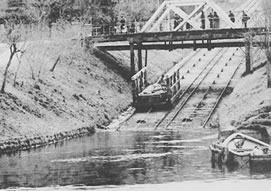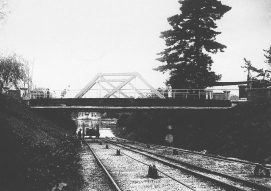Column <Kansai>
3 Kyoto Incline and Lake Biwa Canal
What is the Incline?
See the picture of the Incline published in "Kyoto Meishocho" (1907). It was taken at Keage (Higashiyama-ku (Higashiyama Ward), Kyoto-shi (Kyoto City)), located at the east end of the Kyoto Basin.
The word "beauty spots of Kyoto" reminds us of shrines and temples. Many old historic temples, including Yasaka Jinja (the Yasaka Shrine) and Kiyomizudera (the Kiyomizu Temple) also appear in picture books published in the Meiji Era, such as "Kyoto Meishocho" and "Kyoto Meisyo" An unusual item in these is the lncline completed in 1890. It will catch attention as a "new" beauty spot of Kyoto of the time.
The "Incline" is also called as the "inclined railway, " comprising the rail, machine and related facilities installed to convey cargo on a sloping surface of canals, mountainside and others. The Kyoto Incline was also a railroad to tow boats using a hydraulic power generation system. As one looks at the center of the photo, the rail and a carrier on the rail can be seen. The carrier becomes a bedplate to carry boats.
The Incline and Lake Biwa Canal
Why was a railroad required to carry boats? The Incline was made as a part of the canal construction (1885-1890) to pull water from Lake Biwa into Kyoto. The overall length of the Incline is 587 meters.
Before the Canal construction, people and horses were only means of transportation between Kyoto and Otsu, so it was difficult to transport massive loads. Therefore, people were looking forward to the construction of the Lake Biwa Canal that would open a waterway to transport goods by boat, which was intended to contribute the development of Kyoto, after the capital was relocated to Tokyo.
The Canal project was not just a enormous project to connect the distance of 20 kilometers from Lake Biwa to downtown Kyoto through many mountains, but it was also a comprehensive development project to improve waterway transportation in addition to acquire water for the city, irrigation, power generation and other uses.
The Canal starts from Otsu where Lake Biwa is located, goes through many tunnels including ones dug under Mt.Nagara, running along the foot of mountains, and arriving in Keage. From Keage, boats go down a steep of 35 meters using the Incline, to enter Kyoto's city-center through the Kamo River.
Boats can not go down a steep slope alone, so the construction of a railway (Incline) was required to carry the boats on the steep. [Photo 2]
The heading attached to the picture on the right here conveys the astonishment of the people who saw the Incline in those days. It says 'What progress in the era of material civilization it is that unattended boats can climb a mountain, which is the most surprising attraction at the construction site.'
Kunimichi Kitagaki, Governor of Kyoto Prefecture, and a Civil Engineer Sakuro Tanabe
Although the idea of constructing the Canal was around since the Edo period, it was Kunimichi Kitagaki (1836-1916), the third Governor of Kyoto Prefecture, who promoted the construction in spite of the amazing cost of 1,250,000 yen (it was an extraordinary price for that time).
The Governor Kitagaki found a civil engineer Sakuro Tanabe (1861-1944) and appointed him as the project's chief engineer. He was appointed a Kyoto government official in 1883, at the young age of 21. He was such a young genius that the prototype of the concept for the Canal had already been done as his graduation thesis at Kobu Daigakko (The Imperial College of Engineering) "Biwako Sosui Koji no Keikaku (A Plan for Lake Biwa Canal Construction)."
In 1888 when hydraulic power was successfully generated at Aspen in the United States for the first time in the world, Tanabe immediately visited the site. Tanabe contributed a great deal towards the decision to construct a hydroelectric plant during the Lake Biwa Canal construction. As a result, the Japan's first hydroelectric plant started its operation here in Keage.
Currently, the drawings, pictures, and other materials related to the construction are available for inspection at the Lake Biwa Canal Museum (Website of the Kyoto City Waterworks Bureau (Japanese)), or you can find some in Tanabe's book "Biwako Sosui Koji Zufu."
The Incline as a Civil Engineering Heritage
The operation of the Incline was halted in 1948 due to the decline in waterway transportation.
However, the Incline was designated as a cultural property of Kyoto-shi in 1983, being acknowledged as a civil engineering heritage. In association to the construction work of Keage Station on the Tozai Line (Kyoto Municipal Subway) that opened in 1997, some reconstruction work was done on the Incline.
The techniques of embankment and masonry to support rails, as well as rails made in England or by Yawata Iron and Steel Works. The Incline is a valuable heritage showing an integration of historic civil engineering techniques. On both sides of the railway cherry trees were planted, known for their magnificent cherry blossoms.
Reference
- Tanabe Sakuro, Biwako Sosui Koji Zufu, Tanabe Sakuro, 1891 【400-45】
- Biwako Sosui Zushi Kankokai (ed.), Biwako Sosui Zushi, Toyobunkasha, 1978 【YP14-496】
- Nishikawa Koji, "Kyoto no Kindaika to Tanabe Sakuro," Kindai Doboku Gijutsu no Reimeiki: Nihon Dobokushi Kenkyu Iinkai Sinpojiumu Kirokusyu, Japan Society of Civil Engineers, 1982 【NA23-E26】
- Matsuura Shigeki, Meiji no Kokudo Kaihatsushi: Kindai Doboku Gijutsu no Ishizue, Kajima Shuppankai, 1992 【DL825-E40】
- "Doboku no Fukei: Biwako Sosui Inkurain (Higashiyama-Ku, Kyoto) - Chikatetsu Koji ni tomonatte doboku Isan o Kaitai, Fukugen," Nikkei Construction, 198, December 26, 1997 【Z16-1928】
- Kyoto Meishocho, Kyoto-shi Sanjikai, 1907 【407-5】
- Kobayashi Chujiro (ed.), Kyoto Meisyo, Kobayashi Shashin Seihanjo, 1907 【94-511】

